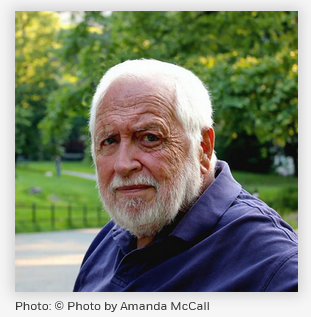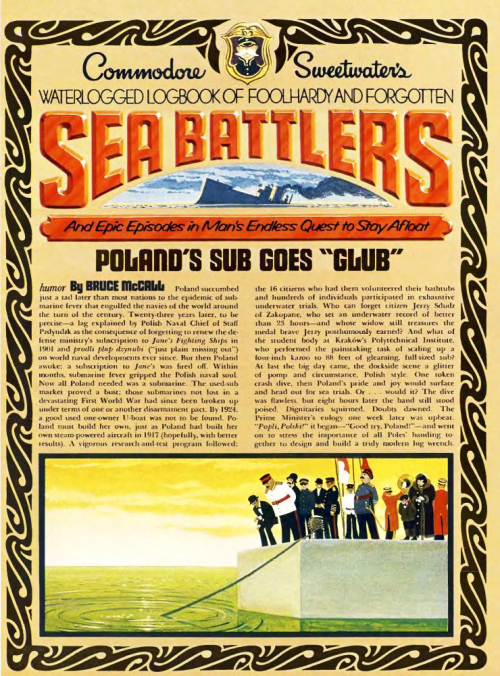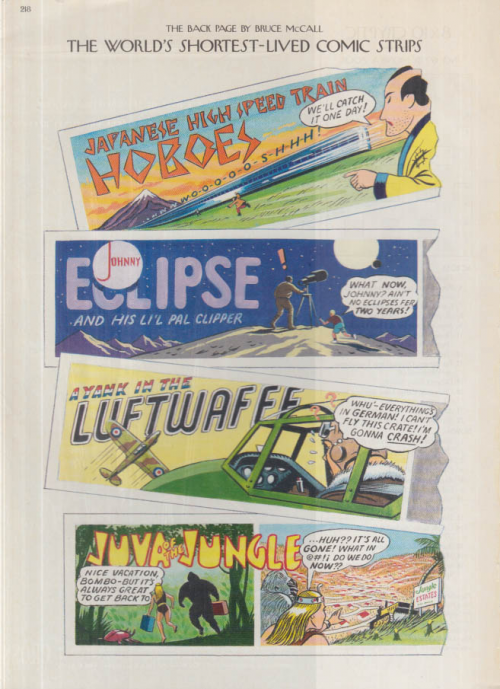Bruce McCall – RIP
Skip to commentsWriter-illustrator-humorist Bruce McCall has passed away.

May 10, 1935 – May 5, 2023
William Grimes at The New York Times reported the loss:
Bruce McCall, whose satirical illustrations for National Lampoon and The New Yorker conjured up a plutocratic dream world of luxury zeppelin travel, indoor golf courses and cars like the Bulgemobile Airdreme, died on Friday in the Bronx. He was 87.
His wife, Polly McCall, said his death, at Calvary Hospital, was caused by Parkinson’s disease.
Design@tive described Bruce’s career evolution:
McCall began his career as an illustrator for car ads — by his own account not a very good illustrator. He’d left the field and became a copywriter when, on a whim, he and a friend sent some humorous drawings to Playboy (at that time, 1970, it was a legit career move).


Bruce partnered with journalist Brock Yates and sold two illustrated features to Playboy in 1971 and then, driving solo, he sold two more illustrated features to the magazine in 1973 and occasionally thereafter.
The N. Y. Times relates Bruce’s reaction to the Playboy sale:
Playboy bought the idea, assigned Mr. McCall to do the illustrations and ran the collaboration in January 1971 under the title “Major Howdy Bixby’s Album of Forgotten Warbirds.” It went on to win Playboy’s annual humor award.
“This went to my head — in fact rearranged its contents,” Mr. McCall told Macmillan in an interview for its website in 2008. “On the basis of that one fluke success, I now felt entitled to see myself as a working professional humorist.”


In 1972 Bruce became a semi-regular contributor to National Lampoon and continued there into 1975, the magazine’s most famed and fortunate period. Fame and fortune came to Bruce too as he became very popular as an illustrator and wordsmith.
Playboy and National Lampoon assignments spread as Car and Driver, Automobile Magazine, Golf Digest, Vanity Fair, The Walrus, The New York Times, Esquire, and others came calling.


Jamie Kitman for Car and Driver paid tribute to Bruce on the news of his passing:
Bruce McCall, one of the funniest men to ever write about cars—and also sketch, draw, and paint them with inimitable style—died yesterday at 87, owing to complications arising from Parkinson’s Disease … McCall distinguished himself to the car-loving world with his often acerbic and always hilarious work for Car and Driver and Automobile Magazine. His illustrations, which showcased the automotive and aeronautical themes that first captured his interest during what he would describe as a resolutely grim Canadian boyhood, defined a genre he’d come to call “retro-futurism,” a self-created style that at once mocked and celebrated the over-the-top enthusiasm and huckster’s bluster that characterized mid-20th century American marketing, nowhere more shamelessly than in the sale of new automobiles.

Then there was The New Yorker.
Back to The New York Times obituary:
Infatuated with The New Yorker since childhood, Mr. McCall submitted a humor article for the magazine’s “Shouts and Murmurs” department in 1980, the first of more than 80 to be published over the next 40 years. After Tina Brown became editor in 1992, his illustrations appeared regularly on the magazine’s cover and in the back of the book.

The New Yorker and Françoise Mouly pays homage:
Bruce McCall, the artist behind the cover for the May 15, 2023, issue, died on May 5th, at the age of eighty-seven. McCall, who insisted upon chewing his beloved Groucho Marx cigars long after a taste for tobacco stopped being even remotely acceptable, was a dear friend and a poet at heart. His artistic sensibility was formed far beyond the strictures of art school, first in the stark and frigid landscape of Ontario, then in the stark and frigid world of Madison Avenue advertising.
McCall contributed more than eighty covers (this is his eighty-third) and about as many Shouts & Murmurs columns. “Bruce was a genius,” the New Yorker editor Susan Morrison said.



From Literary Hub Bruce McCall: The Story Behind Eight New Yorker Covers
Bruce’s New Yorker covers can be enjoyed and prints purchased at the Condé Nast store.
More Bruce can be seen at the Bruce McCall website, including his books.
Bruce’s Facebook page is here.
feature image from National Lampoon (July, 1973)


Comments 2
Comments are closed.